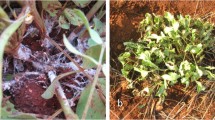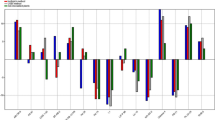Abstract
An important aspect of integrated disease management of Phytophthora root rot, the most serious root disease of Proteaceae in South Africa, is the use of resistant rootstocks. Most commercial cultivars are propagated from stem cuttings that have been rooted in a rooting bed. Inherent resistance properties should, therefore, be present in the stems. The stem inoculation technique for evaluation of resistance properties of various genotypes is desirable because it is very efficient in terms of space, time, labour and cost. Ten isolates of P. cinnamomi Rands representing the A1 and A2 mating types and a range of aggressive abilities were selected for stem inoculations. The effects on lesion length of depth of inoculation and position of measuring the lesion were assessed. The stem inoculation technique was standardised by using superficial inoculations and measuring the lesion just below the bark after 6 days incubation at 22°C. Lesion development on five Leucospermum cultivars was compared after winter and summer inoculations were carried out over three consecutive years. Results showed that it is important to standardise the stem inoculation technique to reduce variation as a consequence of method. The performance of some cultivars was very consistent over all test periods, but others demonstrated variability in lesion length. Assessment of resistance on results of a single test is thus not recommended.
Similar content being viewed by others
References
Botha T, Wehner FC, Kotze JM (1990) Evaluation of new and existing techniques for in vitro screening of tolerance to Phytophthora cinnamomi in avocado rootstocks. Phytophylactica 22, 335–338.
Butcher TB, Stukely MJC, Chester GW (1984) Genetic variation in resistance of Pinus radiata to Phytophthora cinnamomi. Forest Ecology and Management 8, 197–220.
Dixon KW, Thinlay P, Sivasithamparam K (1984) Technique for rapid assessment of tolerance of Banksia spp. to root rot caused by Phytophthora cinnamomi. Plant Disease 68, 1077–1080.
Dolan TE, Coffey MD (1985) Laboratory screening technique for assessing resistance of four avocado rootstocks to Phytophthora cinnamomi. Plant Disease 70, 115–118.
Englander AW, Turbitt W (1979) Increased chlamydospore production by Phytophthora cinnamomi using sterols and near ultraviolet light. Phytopathology 69, 813–817.
Fry WE, Spielman LJ (1991) Population biology of Phytophthora infestans. In ‘Advances in plant pathology’ — Vol 7 (Eds DS Ingram and PH Williams) pp. 177–199. (Academic Press: London)
Hoitink HAJ, Schmitthenner AF (1974) Resistance of Rhododendron species and hybrids to Phytophthora root rot. Plant Disease Reporter 58, 650–653.
Jeffers SN, Aldwinckle HS, Burr TJ, Arneson PA (1981) Excised twig assay for the study of apple tree crown rot pathogens in vitro. Plant Disease 65, 823–825.
Knox-Davies PS, van Wyk PS, Marassas WFO (1986) Diseases of Proteas and their control in the South-western Cape. Acta Horticulturae 185, 189–200.
Linde C, Drenth A, Kemp GHJ, Wingfield MJ, von Broembsen SL (1997) Population structure of Phytophthora cinnamomi in South Africa. Phytopathology 87, 822–827.
McCredie T, Dixon K, Sivasithamparam K, Watkins P (1985) Seeking Phytophthora resistant Banksias. Australian Horticulture 83, 48–51.
Smith IW, Marks GC (1986) Effect of moisture stress in Eucalyptus sieberi on growth of lesions caused by Phytophthora cinnamomi. Australian Forest Research 16, 273–279.
Solel Z, Pinkas Y (1982) A modified selective medium for detecting Phytophthora cinnamomi on avocado roots. Phytopathology 74, 506–508.
Swart L, Denman S (2000) Chemical control of Phytophthora cinnamomi in potted Leucospermum plants. Australasian Plant Pathology 29, 230–239.
Von Broembsen SL (1984) Distribution of Phytophthora cinnamomi in rivers of the South-western Cape Province. Phytophylactica 16, 227–229.
Von Broembsen SL, Brits GJ (1985) Phytophthora root rot of commercially cultivated Proteas in South Africa. Plant Disease 69, 211–213.
Zilberstein M, Pinkas Y (1987) Detached root inoculation — a new method to evaluate resistance to Phytophthora root rot in avocado trees. Phytopathology 77, 841–844.
Author information
Authors and Affiliations
Corresponding author
Rights and permissions
About this article
Cite this article
Denman, S., Sadie, A. Evaluation of a stem inoculation technique for assessing resistance to Phytophthora cinnamomi in Leucospermum cultivars. Australasian Plant Pathology 30, 11–16 (2001). https://doi.org/10.1071/AP00056
Received:
Accepted:
Published:
Issue Date:
DOI: https://doi.org/10.1071/AP00056




